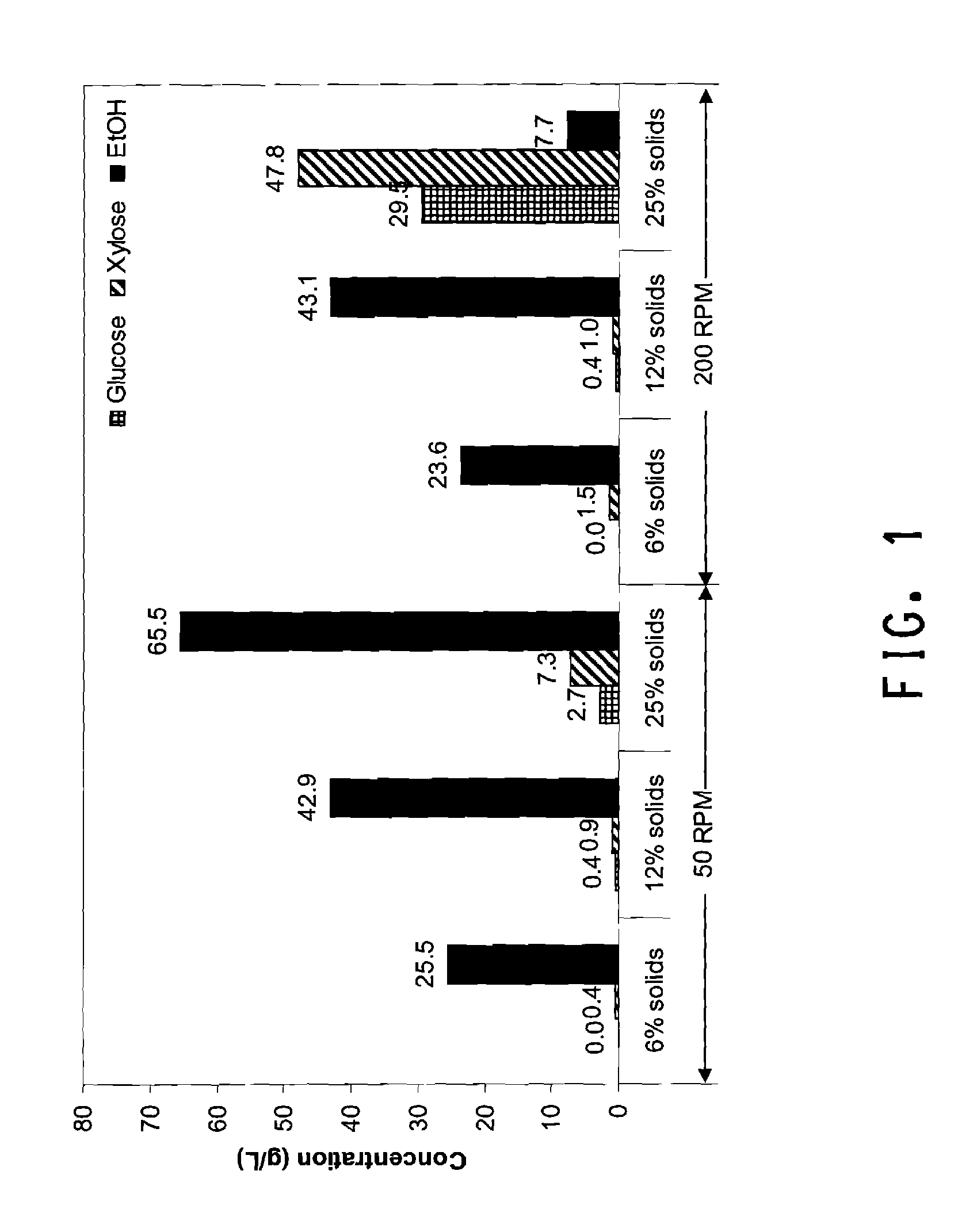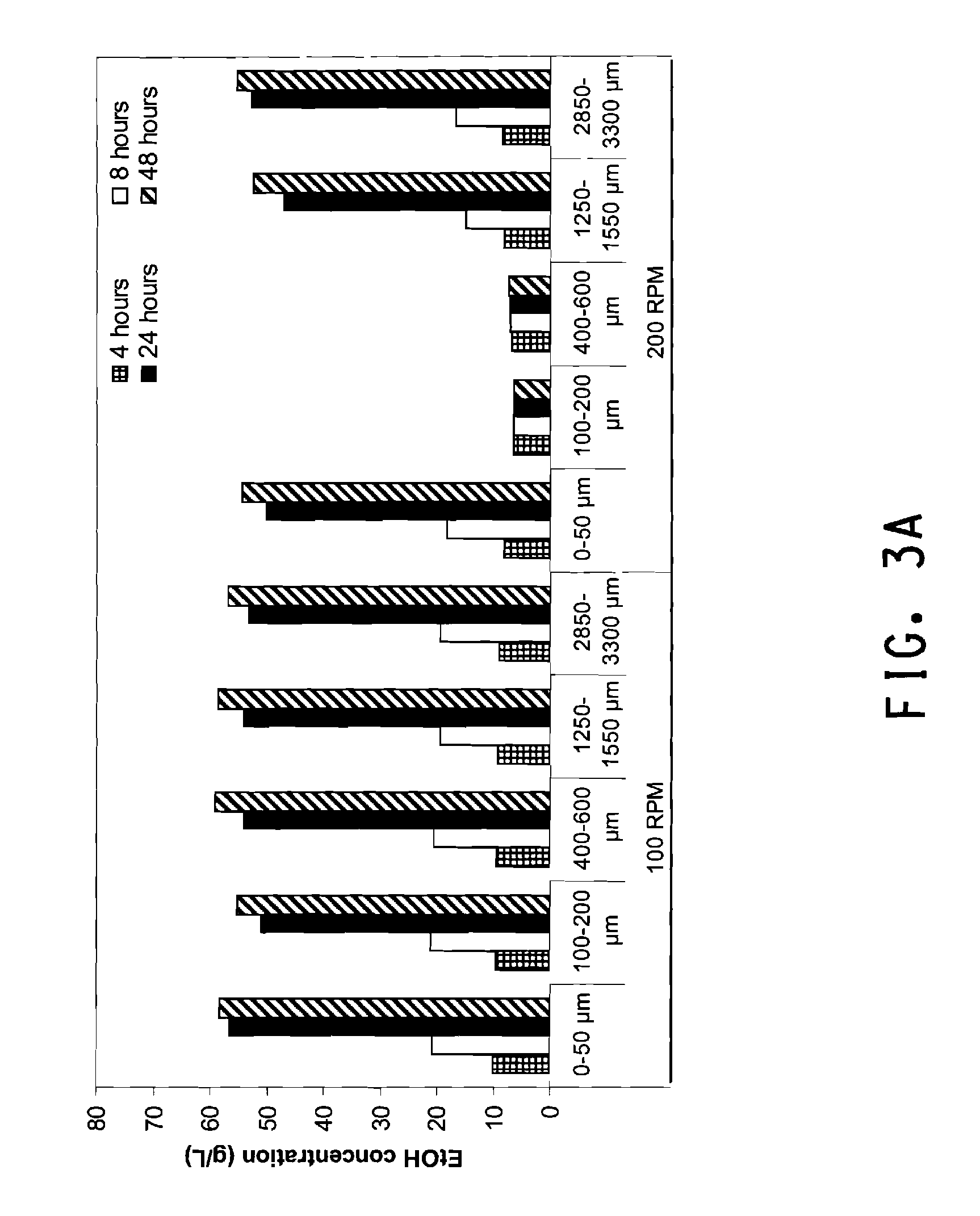Process for simultaneous saccharification and fermentation for production of ethanol
a technology of simultaneous saccharification and fermentation, which is applied in the direction of biofuels, biochemical apparatus and processes, enzymes, etc., can solve the problems of low production of ethanol using these methods, and achieve the effects of reducing performance, strong effect of rpm, and high solids loading
- Summary
- Abstract
- Description
- Claims
- Application Information
AI Technical Summary
Benefits of technology
Problems solved by technology
Method used
Image
Examples
example 1
The Effect of RPM and Solids Loading on SSF
[0124]This example demonstrates the effect of RPM and solids loading on the SSF process using dilute ammonia pretreated corn cob and recombinant Zymomonas mobilis strain ZW705. SSF was performed as described in General Methods for Flask SSF. The experimental runs were carried out at three different solids loadings (6%, 12%, and 25%) and two different RPM (50 RPM and 200 RPM) with H3A protein dosed at 15 mg / g glucan+xylan. Samples were taken after 3 days and assayed by HPLC as described in Materials and Methods.
[0125]The results given in FIG. 1 showed a surprisingly strong effect of RPM on SSF process at high solids loading (25%). The SSF with an RPM of 200 and 25% solids produced only 7.7 g / L of EtOH at day 3, which was primarily carry over ethanol from the Zymomonas inoculum. At the same time, 29.5 g / L of glucose and 47.8 g / L of xylose were accumulated indicating that the H3A enzyme preparation was still effective under these conditions. I...
example 2
The Effect of Particle Size on Ethanol Production High Solids Mock SSF
[0127]To study the effect of particle size on Zymomonas fermentation, Ballotini Soda Glass Beads (VWR, Cat#33997-500 / 536 / 560 / 562 / 568 / 584, West Chester, Pa.) were used in mock SSF runs instead of pretreated corn cob. Beads with the following diameter ranges were washed, sterilized and dried before use: 0-50 μm, 100-200 μm, 400-600 μm, 1250-1550 μm (1.25-1.55 mm), and 2850-3300 μm (2.85-3.30 mm). Similar to conditions described in Flask SSF, reaction size was fixed at 50 g and 25% total solids (glass beads) in stoppered 125 mL Erlenmeyer flasks with 21 Gauge needles for outgassing. In order to mimic available carbohydrates in a standard SSF reaction, media consisting of 80 g / L glucose and 70 g / L xylose was prepared in water and loaded. The media was sterilized by autoclaving at 121° C. for 15 minutes. Zymomonas inoculum was loaded into the reaction mixture at 10% by weight, and no enzyme was added in this case. Eac...
example 3
SSF in Stirred Tank Reactors
Trial 1
[0131]Two Rushton 6-bladed impellers (45 mm diameter) revolving at 100 RPM were used in a SSF scale up as described in Materials and Methods. Impellers were spaced 3 cm apart along the shaft with the bottom impeller spaced 2 cm from the bottom of the reactor. The Saccharifying enzyme was H3A protein which was loaded at 20 mg protein / g (glucan+xylan). With the 25% solids loading used, the Rushton impellers did not provide adequate mixing. Visual observations revealed significant solids settling, poor axial mixing, CO2 build-up trapped within the reaction slurry, and highly localized radial mixing around the impellers. Due to the non homogeneous mixing, estimates of power input during the SSF run could not be made. However glucose, xylose, and ethanol concentrations were determined over 140 hours by sampling and HPLC analysis, and the pattern of glucose, xylose and ethanol accumulation (shown in FIG. 4) indicates a normal saccharification rate but in...
PUM
| Property | Measurement | Unit |
|---|---|---|
| concentration | aaaaa | aaaaa |
| particle size | aaaaa | aaaaa |
| particle size | aaaaa | aaaaa |
Abstract
Description
Claims
Application Information
 Login to View More
Login to View More - R&D
- Intellectual Property
- Life Sciences
- Materials
- Tech Scout
- Unparalleled Data Quality
- Higher Quality Content
- 60% Fewer Hallucinations
Browse by: Latest US Patents, China's latest patents, Technical Efficacy Thesaurus, Application Domain, Technology Topic, Popular Technical Reports.
© 2025 PatSnap. All rights reserved.Legal|Privacy policy|Modern Slavery Act Transparency Statement|Sitemap|About US| Contact US: help@patsnap.com



